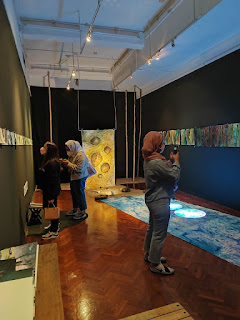When it comes to curatorial practice, one of the key factors is the quality of audience engagement and visiting experience. This factor has become increasingly pertinent due to the current Covid-19 S.O.P requirement for indoor public spaces. The previous quantitative emphasis on numbers of visitors as the key performance indicator has to be shifted to meaningful engagement and visiting experience. In responding to this shift, Muzium & Galeri Tuanku Fauziah (MGTF USM) was prompted to re-define and re-identify its audience, whilst reforming its curatorial paradigm, models and strategies.
MGTF USM has continuously been collecting data on its audience since 2010. It has also embarked on several research projects in its effort to ask fundamental questions regarding its audience such as the profile, motivation, preference, sattisfaction, perception, voice and feedback. The methods include open interviews, surveys, informal conversations and video recording.
The findings have shown that MGTF's audience is largely consisted of secondary school students, followed by primary school, kindergarten and USM students, family groups as well as students from other universities and colleges. Most came in groups for learning tour and research purpose. They were interested in history and anthropological artifacts, traditional arts, astronomy and fine art. As for subjective emotional experiences, most have chosen curiousity, awe, happy, jovial, proud and respect as their preferences.
These are only few examples of findings that have been very instrumental in outlining audience-centered curatorial paradigm and strategies for MGTF. The paradigm must place both the arts and sciences in a complimentary symbiosis. One example is the regional traditional paradigm based on many Eastern forms of sustainable cosmology. It is in such paradigm that several key principles can be co-opted. The principles include modularity and adaptivity, flexibility, portability, non-linearity, inter-connectivity, cyclical, interactiveness and immersivess, convergence and multi-disciplinary. Few curatorial strategies can be explored. These include the application of non-formal artscience learning models such as multiple intelligences, learning styles cycle and whole brain learning. Other strategies include the use of interactive element, emphasis on awe and curiousity, encouragement of participation and interpretation through co-creation and creative audience intervention. Few studies have shown that exhibitions would increase engagement if designed with emphasis on attracting power and retaining value (a measured ability to retain interest). In addition, co-creation method and creative audience intervention have been shown as having the potential to increase inclusivity and diversity of audience's voice into an exhibition.
Recent exhibitions such as "Open Wall" and "Project Monyet" deployed the above-mentioned strategies, especially in regards to co-creation and creative audience intervention. Current exhibition "OASIS 2022: Sensoria" has also co-opted several of the principles and learning models mentioned above. Formal and informal surveys conducted during the durations of these exhibitions have shown that the deployment of the above-mentioned curatorial paradigm, models and strategies have contributed significantly in increasing the quality of engagement and visiting experience. It has also shown that by including its audience as active participants of meaning making, MGTF has developed a sense of belonging in the hearts of its beloved audience or visitors.






















No comments:
Post a Comment